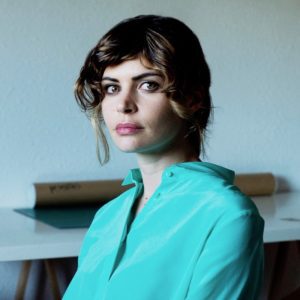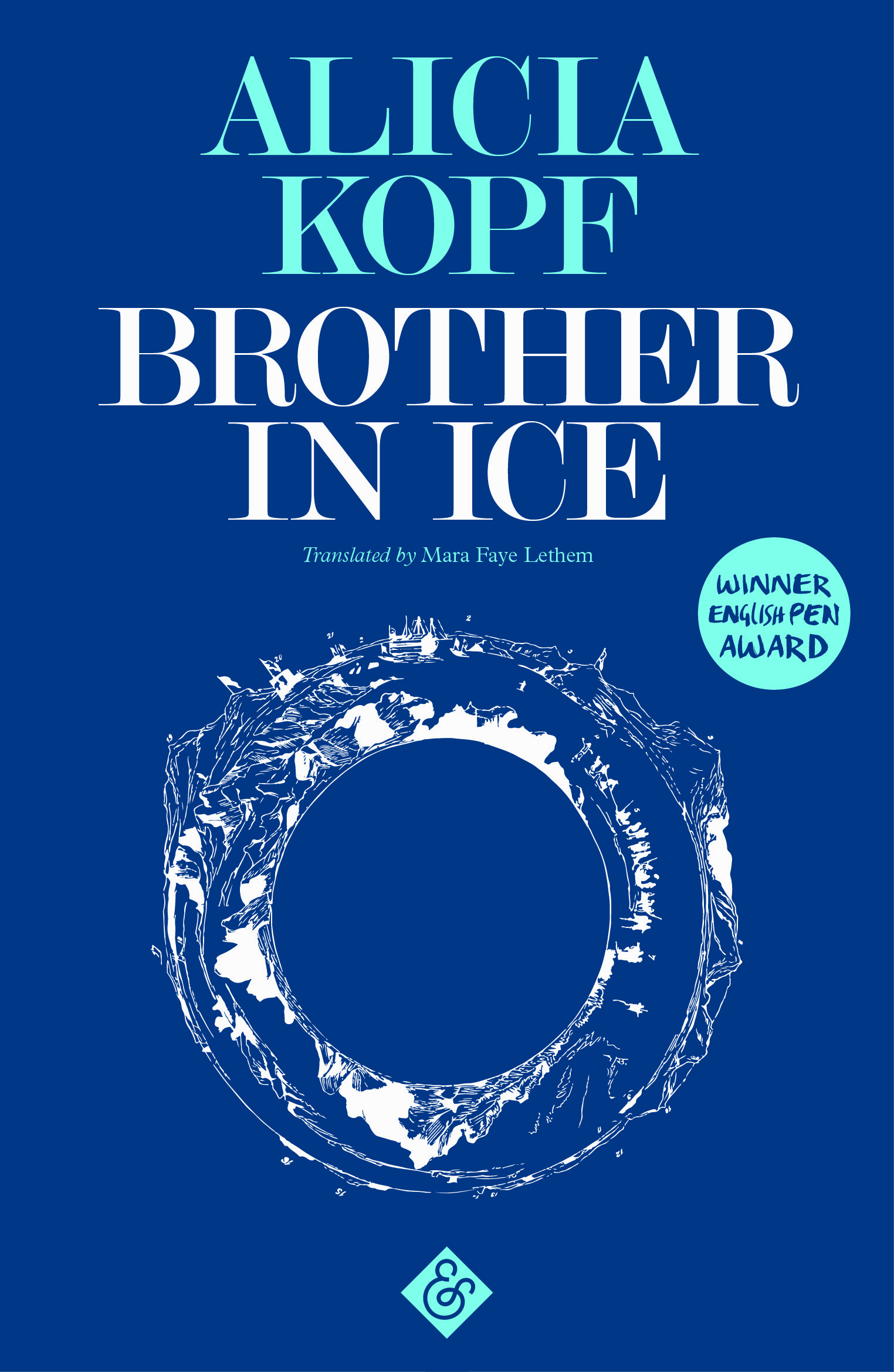
Frozen explorers, hollow narrators, a brother suddenly unsure how to close his bedroom door—Brother in Ice is a lyrical peregrination that posits human relationships as a landscape of ice and snowstorms in which your true coordinates are impossible to define. It is a book that questions, piercingly, whether efforts to know oneself and one’s family ultimately enlighten or confuse. “I wonder if after all these years of study, work, and more or less failed relationships, Kopf asks, “I’ve been polishing myself or eroding myself. Is what’s left a gem, Kopf or a rock?” (Read an exclusive excerpt from the book here.)
Until the publication of this novel, Alicia Kopf (a pen name for Imma Ávalos Marqués), was primarily known in her native Spain as a multidisciplinary artist, where solo shows such as her premiere at the Galeria Joan Prats in Barcelona won her a GAC-DKV prize for the best young artist’s show. It was in fact a cycle of art exhibitions (Àrticantàrtic) dedicated to the obsessions of polar explorers that led Kopf to write her debut novel.
Interestingly, Brother in Ice has gone through as many permutations as the age-old ice that so inspires Kopf. The book began as Germà de Gel in 2015, written in her native Catalan, which won Kopf the Documenta Prize for Catalan authors under thirty-five. In 2016, the Spanish edition came out as Hermano de Hielo with Alpha Decay, earning Kopf the prestigious Premi Llibreter prize in the same year. The English edition, exquisitely translated by Mara Faye Lethem, was released this year with And Other Stories, a UK-based publishing collective that crowdsources their supporter’s suggestions to bring exceptional books in translation to a wider audience.
At the time of writing, the English version of Brother in Ice is the number one new release in the “Polar Region Travel” category on Amazon. Is this a miscategorization? Is the miscategorization itself a form of performance art? Must travel guides actually lead you somewhere, or can they help you lose yourself? A recent review in the Guardian questioned the validity of the “novel” attribution given to Brother in Ice, and apparently, Amazon does as well. A deeply poetic collage of arctic research notes, photographs, mini-biographies and polar glossaries share space with diary entries—both fictionalized and not—that deep dive beneath the surface of the narrator’s brother’s autism to examine (and sometimes exacerbate) the fissures his condition has caused within her life. Very few of the explorers Kopf profiles in the book reach the place that they’d set out for, and it will be up to the reader to determine whether Kopf’s reaches her destination, either. Even the explorers who think they’ve reached their goal post are later deprived of this satisfaction: time and posterity come in to prove that they’d been off course the entire time, that they’d “discovered” a pole that had already been found by a competitor, had “conquered” a bleak and hostile area that had always existed, and would continue to exist, without concerning itself with whether it had been found.
The perhaps insurmountable task of knowing—truly knowing—the geographic coordinates to your own emotional life is achingly depicted in this book that celebrates both the valiant failings and the crystalized successes of the human enterprise. During both her Àrticantàrtic series of art installations and the writing of Brother in Ice, Kopf kept researching and producing, grappling and despairing. She isolated herself from friends and families to go further, look deeper, cut into the ice.
Gripped with what she calls her “white obsession,” Kopf’s narrator travels to Iceland only to end up sharing a dingy hostel room with a garrulous American, dancing with enormous Danes to Taylor Swift singles and signing up for day excursions while she waits for her lost luggage. The American keeps offering her French fries, she begrudgingly shares a jacuzzi with an older poet while his friends look on admiringly, the bus driver shouts facts about the island’s surface to his ticketed day trippers, but the passengers can’t hear him. On her last night in Reykjavik, the narrator questions the purpose of her pilgrimage, only to realize upon waking that she hadn’t experienced a single moment of the nostalgia that usually plagues her while she was in Iceland. “It’s much easier to get to the arctic,” Kopf writes, “than to reach certain areas of one’s self.”
Novel, travelogue, thesis, memoir, this unwieldy gift: in its furious quest to understand everything while reverencing the unknowable, perhaps Brother in Ice does belong in the Polar Arctic Travel section of the world’s biggest electronic commerce company, right near the current fifth-place holder, The Outpost of the Lost.
Alicia and I corresponded by email about her thrilling debut.
***
The Rumpus: At one point in the book, you suggest that “affection” is the most highly valued asset in expensive schools. Can you expound on this—do you think this is true?
Alicia Kopf: Before I could make a living from my art I worked in different sorts of schools. One of them was a private expensive school where the parents were so busy (most of them were rich and/or famous) that the care of their children was often delegate to different paid caregivers. In terms of affection, some of these children were poor. At the same time (and that makes them different from the less privileged), these children were very powerful and they were aware of that: if some of them didn’t like a teacher and convinced their parents, the teacher would be fired. I think love and care is very fundamental in education, and the family is not the only necessary source of it, I just feel that in this specific context other interests were mixed. I wonder how growing in this atmosphere shapes a person.
Rumpus: The back jacket describes this as a “hybrid novel”: part travelogue, part fictionalized diary, part research notes. I’m interested in hearing more about your process of fictionalizing the diary entries. How did you go about feeling out when the truth was needed? How did you know when it was time for fiction?
Kopf: The writing process comes from both journaling and rewriting to shape a literary artifact where everything is connected through a metaphor. In Brother in Ice the metaphor was polar exploring. This metaphor is something I research quite deeply as it gives a structure to the whole book; it’s the lens through I will look at reality during a long period of time. In real life there is not a general concept, things are often meaningless and disperse, so I reshape my experience into something that makes some sense, that illuminates some kind of aspect of life beyond the real people and facts that inspired it.
Rumpus: In another section, you write that “an inexpressible story can kill the person who lived through it.” Do you want to talk about the ways in which people are kept from telling their stories? Or what makes a story impossible to express?
Kopf: Both aspects are related: this sort of hidden “killer stories” are in part the result of social repression and/or they often don’t emerge because we don’t recognize that they are within us until we recognize it somewhere else; in the press, in literary fiction, etc. We need narrative patterns to understand reality. Creating a new narrative pattern is very difficult, almost an heroic task, it’s walking on ice: very disorientating and lonely. But if you find the way, you will give a survival tool to the readers.
Rumpus: For a book that is very much about being an outsider, what is it like to have your work translated in a language other than your native tongue? Have you read the English translation? Did you play a role in the translation?
Kopf: I think a writer, especially in a first novel, is always an outsider. Now I’m invited at important cultural events, but I’ll always feel like an outsider that has sneaked in the party.
Being translated into English is a great opportunity and also a proof that the story can be read outside its national context. For me it is very important, because I want my stories to be universal. I read Mara Faye Lethem’s translation before it was published; she is a great translator and asked me about the details of the translation that she thought were important to discuss.
Rumpus: The mother/daughter dynamic in this book is beautiful and conflicted and very complicated. What has the process of being published been like for you, of having family and friends be able to read you, and imagine that they are either in the book or not?
Kopf: It’s always difficult to write about one’s own family, and I think it’s even more difficult for women because we are educated to be people-pleasers and often solvers of the conflicts within the family. Brother in ice is mainly a research about important aspects of my identity (as having an autistic brother), and when I wrote it I didn’t think about it being published, I just wanted to discover who I was and where all this family ice came from. Depicting some aspects of the real relationship with my mother was unavoidable. I gave her the original to read before publishing the book and she was angry, especially because of the description of my brother. I suppose it is very difficult for a mother to accept this depiction of a son, even if its very realistic and precisely because of that. My perspective as a sister gives me a more horizontal point of view. After some months she understood that this description would help people understand better what is autism and what represents to a family, so she was proud. Other families with autistic members or any member with disabilities have expressed gratitude to me to show some of the habitual dynamics as they are not often represented in literature in a natural way.
Rumpus: In your research notes about Captain Shackleton’s dangerous mission across the Antarctic, you write that “something sank inside the captain” when he returned to solid ground, that “the domestic realm can be the most difficult territory to settle.” I found this very striking and true. Could you expound on what you meant?
Kopf: I think being in the challenging state of adventure with its peaks and its epic nature makes for an easy comparison to some sort of family relationships, the ones one cannot choose or avoid and one has to endure through the whole life. Usually the home is a land of drama, also of joy, but I’m not talking about it in this book: In Brother of Ice I wanted to bring the epic inside the home.
Rumpus: My understanding is that you a cycle of art works for this project. Why did you feel that a book was necessary to complement—or perhaps complete—this cycle of works?
Kopf: When I started this cycle called Articantartic I knew I wanted to write a novel, but as I was then considered a visual artist and I got offers to exhibit, I used my research materials and my drawings as exhibition materials and I let the new materials and experiences that came up to feedback the narrative process. Some of the drawings I exhibited then are also in the book.
Rumpus: Is all of your creative work attributed to your pen name, “Alicia Kopf”? If you are comfortable talking about it, why did you want a pen name?
Kopf: My real name is public, I don’t hide it, but as I inherited it I like to create my own. Alicia Kopf is the name of a character in my first book. It was an artistic book with images and almost no text, and the image of a girl who was headless. She was looking for her head—her identity—through the blank pages of the book. I still do the same, but through literature.
***
Author photograph © Laia Gutierrez.





